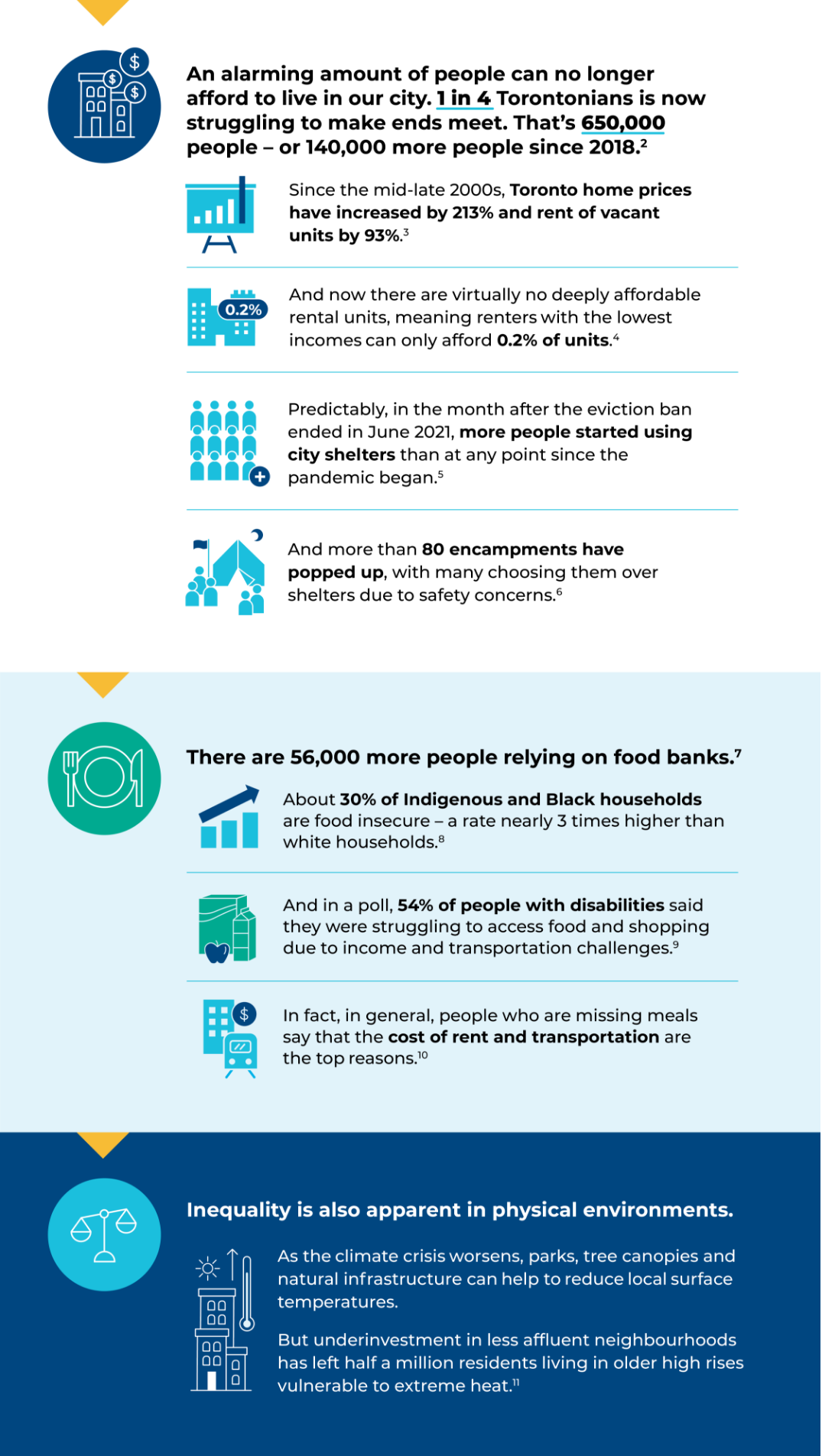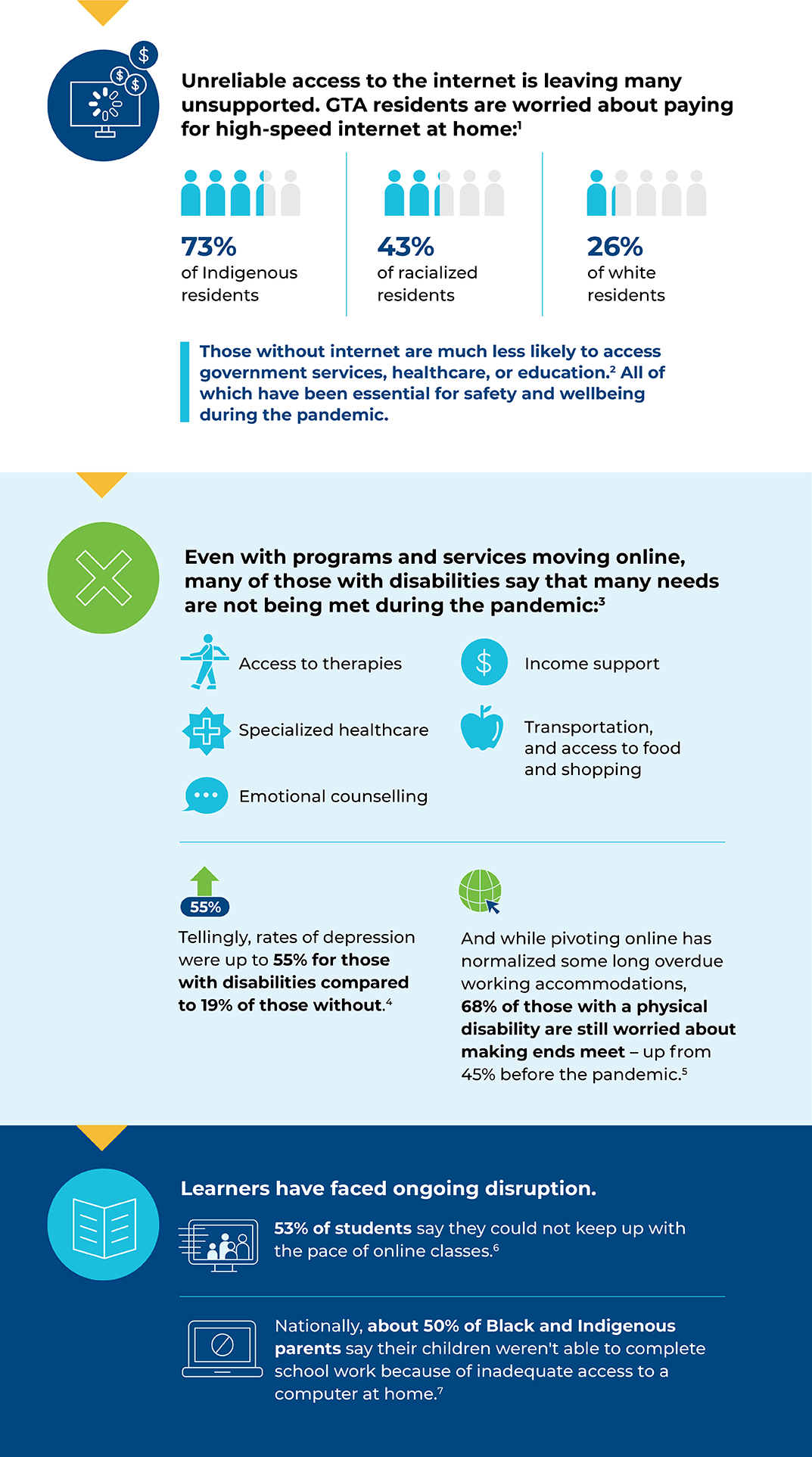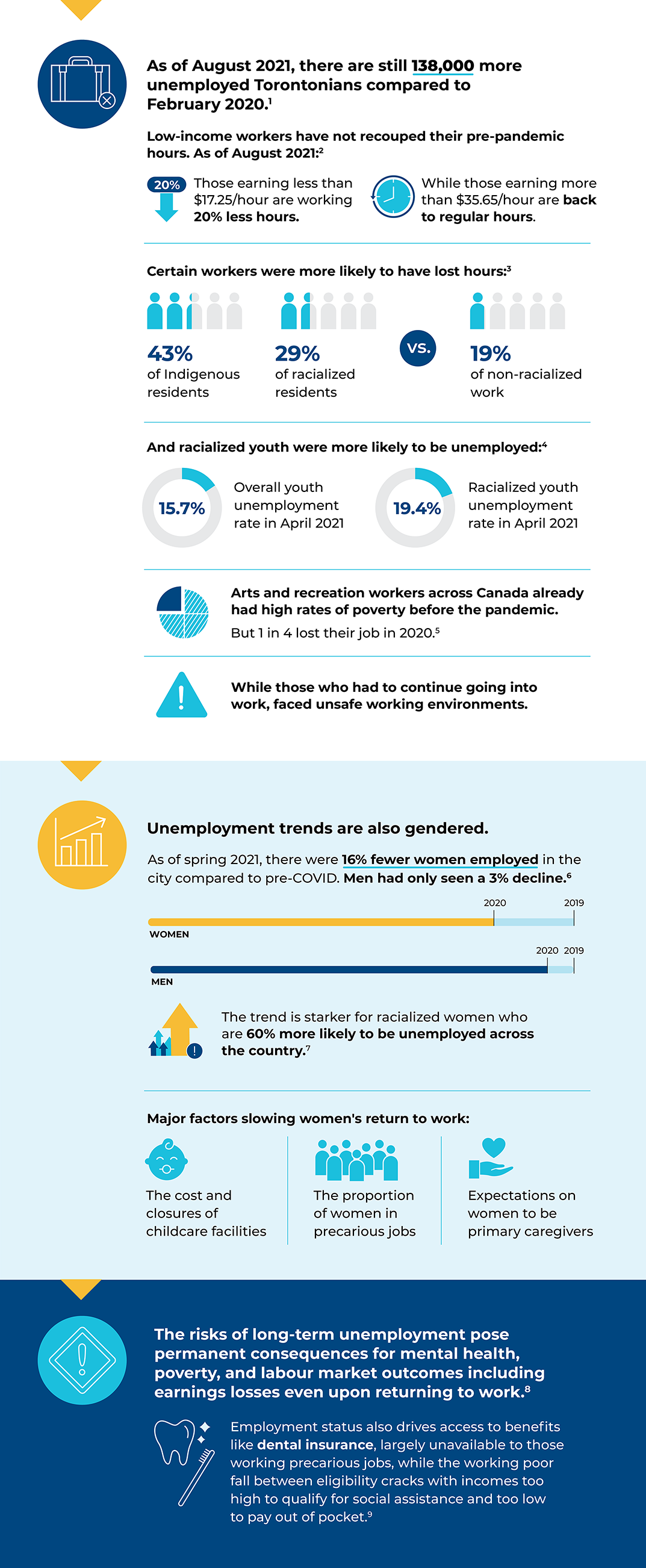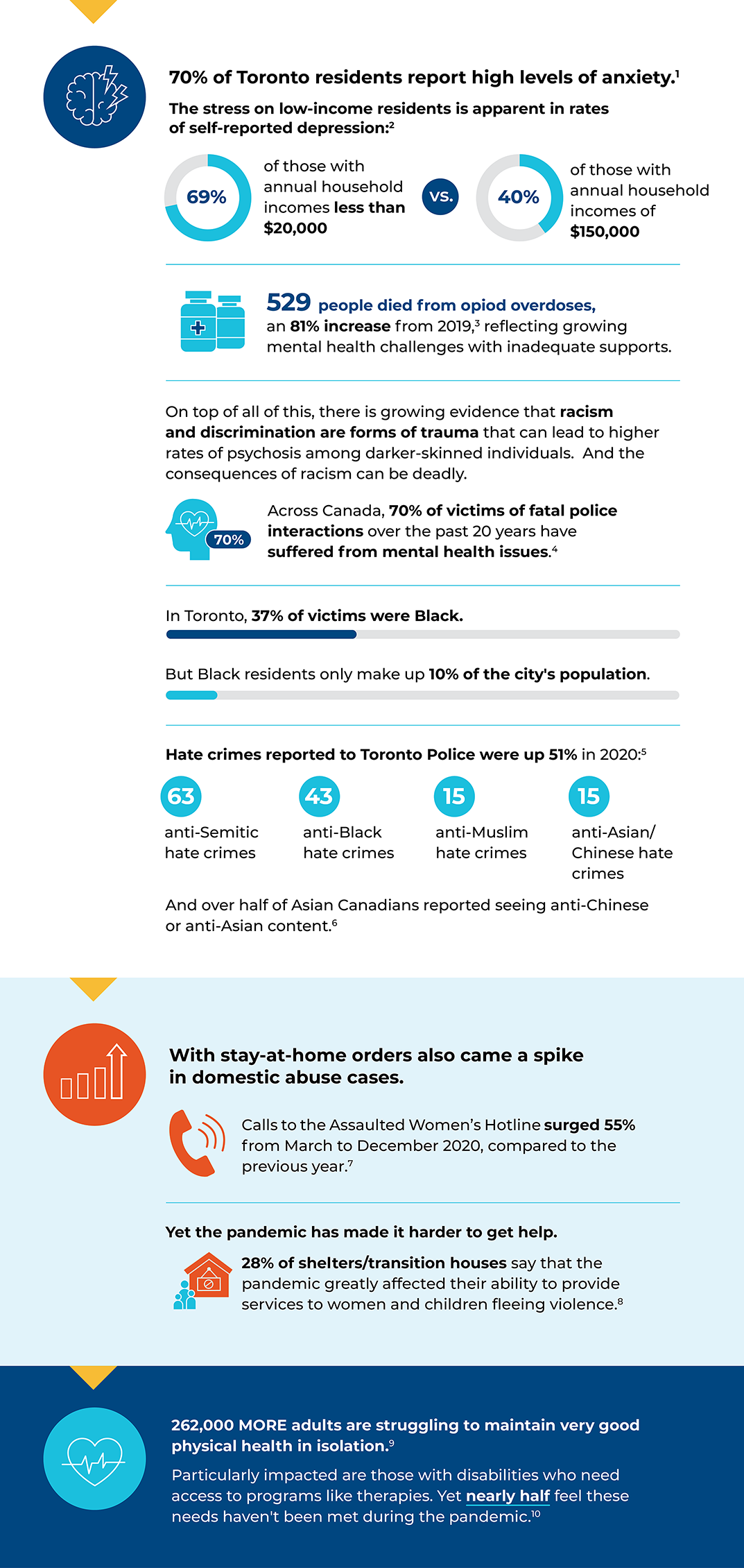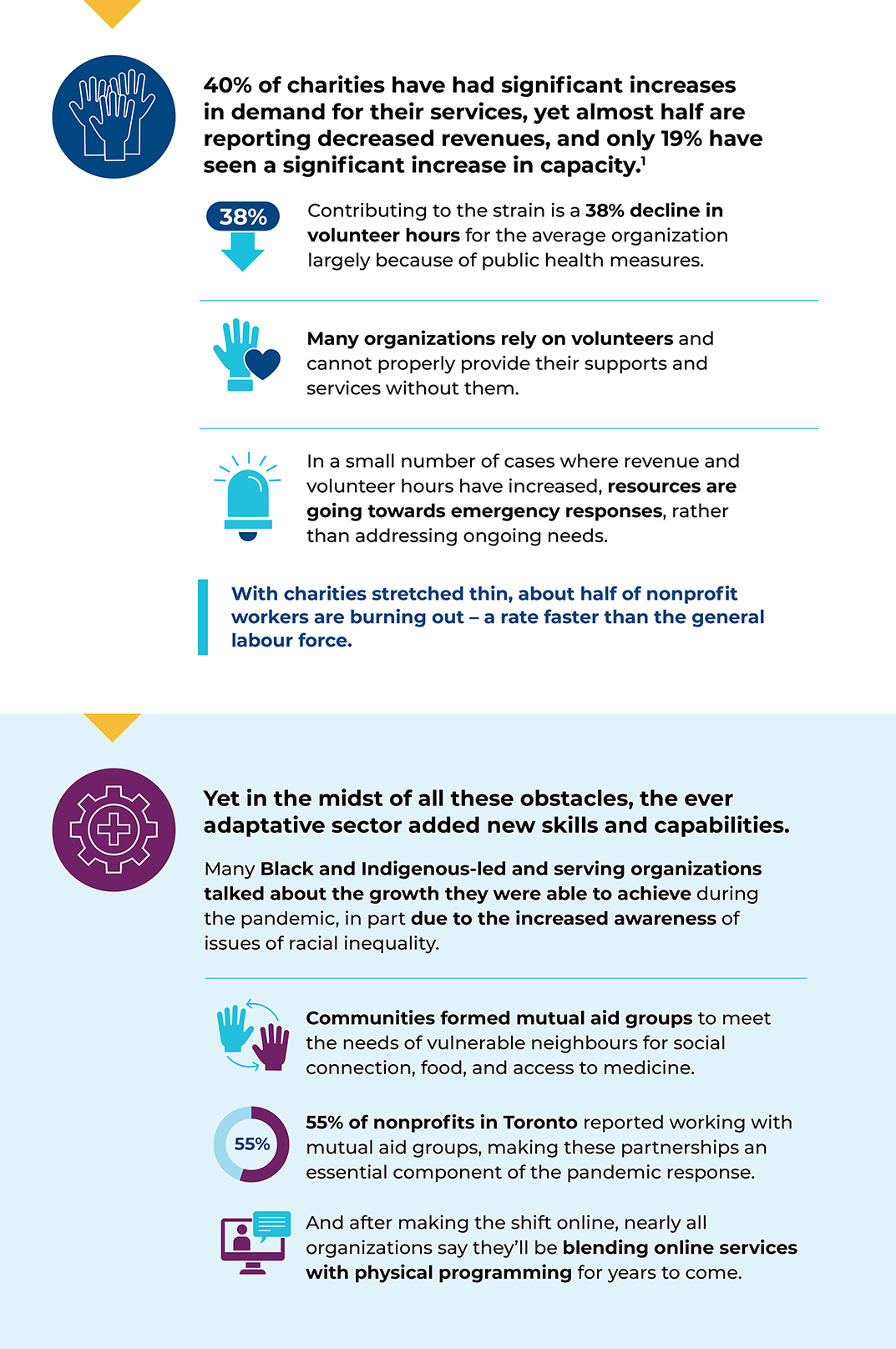This is the 18th Toronto’s Vital Signs Report. Our most in depth and broadly cited report tracks 10 quality of life issue areas and amplifies the voices of sector leaders. Their insights and hopes for a better future informed our data analysis and the opportunities and obstacles to getting better.

Trends in toronto
The cross-cutting trends that have emerged or been amplified through the pandemic.

The Issues
To contain the virus spread, Toronto has had more severe and prolonged lockdowns than nearly any major city in the world. The social and economic fallout of this has been more severe than in most Canadian cities. Particularly pronounced has been the role that social distancing has played in declining mental health, food insecurity, and the overall wellbeing of people with disabilities.
While we struggled with the public health crisis, numerous pre-existing health inequities were brought to the fore. The parts of the city with the highest poverty and the highest percentage of racialized people have long experienced much lower rates of life expectancy and higher rates of numerous diseases. In the pandemic, they were hit again, bearing the brunt of infections and deaths. Even as the city began to recover from the pandemic, the slow rollout of vaccines in the places that were most affected highlighted long-time systemic barriers, including an uneven distribution of the health infrastructure.
Covered in this chapter:
- Mental health is at crisis levels
- Suicial ideation is up significantly, particularly among young people
- Food bank usage at record highs
- Community organizations play a key role
- Increased income support needed to reduce long-term food insecurity
- Disability a major factor in the pandemic fallout
- *Special feature: 5 key findings linking dental services to quality of life. Read more in the soon-to-be released oral health report published by Green Shield Canada and Toronto Foundation.
The unequal impacts of the pandemic underlined the racialization of poverty in Toronto. Low income workers who are more often racialized have not yet recovered their pre-pandemic working hours, and the situation is worse in Toronto than the rest of the country. And for those on social assistance and unable to work, there was no relief. On the other hand, the pandemic was only a blip on the income levels of wealthy and mostly white Canadians, who quickly recovered any lost hours and have seen the value of their stock portfolios and houses soar.
Covered in this chapter:
- Low-income workers hardest hit
- Growing difficulty making ends meet during the pandemic
- Unprecedented wealth creation for some Canadians
- Increased demand exceeds capacity for social service nonprofits
- Deficiencies in pre-existing income supports highlighted by CERB
- High time for tax policy reform
High-income workers were easily able to transition to work at home and continued to receive their full salaries, many low-income workers either lost their jobs or had their hours reduced, and in many cases had to continue working in unsafe environments.
Women have disproportionately suffered job losses (especially racialized women), often working in service sectors that have been subject to significant reductions during the pandemic and they have also assumed the majority of childcare responsibilities that have resulted from school closures due to uneven caregiving.
There has been some societal appreciation for “essential workers,” the usually low-paid workers who have kept the city running throughout the pandemic. However, despite calls for change, there has been little in the way of concrete policy changes or wage increases to fundamentally improve the lives of these workers.
Covered in this chapter:
- Toronto facing highest labour underutilization rate in Canada
- “Privileged” workers have been mostly unaffected by the pandemic
- Service sector and smaller employers hardest hit of all
- The “she-session” underlines need for national childcare
- Long-term unemployment poses permanent risks
- Heightened respect for essential workers opens doors to policy improvements
Community-based organizations, both formal and informal, play a fundamental role in connecting us, and the strain on them has been severe and will likely outlast the pandemic. For most nonprofits and charities, donations and volunteering tanked and then rebounded to some extent, at least on the short-term revenue side, and staff burnout is high. But, the emergence of grassroots groups as essential components of the pandemic response is a positive turn of events. Communities came together in mutual support to ride out the pandemic and mitigate the damage.
Hope for a better future may be the most promising outcome of all. In the face of the unequal effects of the pandemic, the broad embrace of racial justice and the importance of Reconciliation have emerged as central issues that can guide us forward.
Covered in this chapter:
- Formal volunteering has cratered
- A collective awakening on inequality
- More people feel like they have no one to rely on
- Unprecedented revenue declines for nonprofits, but experience varies by subsector
- Overall financial health of nonprofits improved, but still challenged
- Nonprofits report record declines in donations
- Demand for services growing faster than capacity to meet it
- New skills and capabilities added despite obstacles
- Almost half of nonprofit sector workers burned out
The pandemic experience in our city had an unequivocal impact on the environment, for good and for bad. As residents stayed home, air quality improved, and vehicle emissions decreased, but the volume of residential waste went up. As the weather got warmer, people emerged from lockdown and flocked outdoors, and many reported an increased appreciation of nature. But as past research has shown, the burden of many environmental risks often falls to those already vulnerable. Older, low-income, predominantly racialized residents experience higher deaths from heat waves, have lower access to green space and are also more prone to negative health outcomes arising from poor air quality. The past 18 months, which have so clearly laid bare the inequities upon which our city is built, need to be a wake-up call for how we talk about and urgently address the climate crisis.
Covered in this chapter:
- Heightened appreciation for the great outdoors — but gaps in access persist
- Natural infrastructure presents an equitable solution
- Decreasing greenhouse gas emissions key for Toronto
- Waste diversion rates constant, though garbage increased
- Opportunities for the environmental sector
The physical closure of schools and cancellation of before- and after-school programs together led to sharp increases in hunger for many students who had previously relied on nutritional supports. Parts of the city that are home to more low-income and racialized residents bore the brunt of learning disruptions. Students in those areas were more likely to quickly switch to virtual schooling, as these neighbourhoods had the most severe COVID-19 outbreaks, but students in these neighbourhoods were most likely to struggle with access to high-speed internet, high-quality devices and adequate space to focus on schoolwork.
Covered in this chapter:
- Online schooling falls short of in-person learning
- Students struggling with pace and lack of supports
- Virtual learning more prevalent in lower-income and racialized parts of the city
- Mental health of students a serious concern
- Gaps in access to extra-curricular programming intensified
- Reconciliation fundamental to education reform
- Nonprofits step up to fill gaps with virtual programming
- Hunger an exacerbated factor in learning
- Long-term challenges emerging that need system-wide solutions
Where it was possible, the shift to online kept organizations afloat, the livelihoods of some workers intact and the hearts and minds of residents engaged throughout the dark days of the pandemic.
While the pace of recovery is uncertain, the move online offers some organizations the opportunity for audience expansion. The historic dependence on face-to-face interaction has been an obstacle for many whose location and/or financial limitations have precluded them from participating in the past. The forced shift to virtual programming without a doubt offers immediate-term potential for greater access, and this will help address well-documented gaps, particularly for low-income and populations that are otherwise being marginalized.
Covered in this chapter:
- Arts, culture, recreation and sports organizations continue to struggle
- Arts workers are suffering, and many may have left the sector permanently
- Some arts organizations successfully went online during the pandemic
- A long recovery expected
- Equity and fees are major problems
- Pandemic learnings hold hope for brighter future
- Rethinking our cultural spaces and accessibility
While overall crime went down in 2021, some neighbourhoods experienced spikes in violent crime, and intimate partner violence reached alarming levels. The extreme hardships experienced by some are no doubt a factor here. There’s no starker example of this than in the record 529 deaths from opioid overdoses, an overlooked but contingent fact in the unfolding story of COVID-19.
History has shown that hate crimes often rear up when fear and mistrust dominate. The foundations of Toronto’s great diversity have certainly been rocked with hate-related complaints to police up 51% in 2020.
But it was the role of policing itself that took centre stage, and many believe this is a sign of necessary change to come.
Covered in this chapter:
- Overall police-reported crime down
- Violence increasing back to pre-pandemic norms
- Domestic disturbances also on the rise
- Reported hate crimes against Asian, Black and Jewish people increasing
- Opioid crisis further heightened
- Role of police in crisis response comes to a head
Despite recent big announcements of major capital investments in transit, the Toronto Transit Commission (TTC) continues to be one of the transit systems with the lowest public funding in North America. Without additional subsidies, declines in ridership will likely necessitate fare hikes in order to offset losses. And this will mean the burden will fall to those least able to afford them, disproportionately, women, essential workers, racialized residents and low-income residents.
As transit has been hard hit, the rise in active transportation offers a ray of hope. People have taken up walking and cycling in droves. Yet, access to infrastructure has been unequal. At the same time, social distancing measures dramatically reduced mobility around the city, driving social connectivity online. Those with weak or no access to the internet suffered the consequences.
Covered in this chapter:
- Risk of transit “death spiral” real
- Understanding ridership key to future TTC financial model
- Investments in transit infrastructure continue
- Active transportation on the rise
- Access to internet and technology
Amid the economic disruption of the pandemic, 11% of rental units were in arrears as of October 2020, and as eviction bans were lifted in June 2021, the threat of increased homelessness looms.
Adequate housing is a fundamental human right, and successful models of nonprofit and community housing exist, but they require significant scaling up. Housing is the single largest expense for most Canadians. The explosion of housing prices combined with stagnant incomes and low availability of affordable units point to serious concerns for rising housing precarity.
Covered in this chapter:
- Impact of evictions moratorium ending poses serious risk
- Surge in homelessness in months after repeal of the eviction ban
- Toronto one of the most expensive housing markets in the world
- Limited to no rental availability for bottom 40% of income earners
- Lack of affordable housing supply a problem years in the making
- Solutions available when we consider housing a human right




